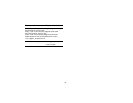55
10BASE-T
The IEEE specification for 10 Mbps Ethernet over Category 3, 4
or 5 twisted pair cable.
100BASE-TX
The IEEE specification for 100 Mbps Fast Ethernet over Category
5 twisted-pair cable.
1000BASE-LX
IEEE 802.3z specification for Gigabit Ethernet over 9/125 micron
core single-mode fiber cable.
1000BASE-SX
IEEE 802.3z specification for Gigabit Ethernet over two strands of
50/125 or 62.5/125 micron core multimode fiber cable.
1000BASE-T
IEEE 802.3ab specification for Gigabit Ethernet over 100-ohm
Category 5, 5e or 6 twisted-pair cable (using all four wire pairs).
Auto-negotiation
Auto-negotiation is where two devices sharing a link,
automatically configure to use the best common speed. The
order of preference (best first) is: 1000BASE-T full duplex,
100BASE-TX full duplex, 100BASE-TX half duplex, 10BASE-T full
duplex, and 10BASE-T half duplex. Auto-negotiation is defined in
the IEEE 802.3 standard for Ethernet and is an operation that
takes place in a few milliseconds. Auto-negotiation nust be
enabled for the 1000BASE-T ports to operate at 1000 Mbps, full
duplex.
Bandwidth
The information capacity, measured in bits per second, that a
channel can transmit. The bandwidth of Ethernet is 10 Mbps, the
bandwidth of Fast Ethernet is 100 Mbps and Gigabit Ethernet is
1000 Mbps.
BPDU
Bridge Protocol Data Unit. A type of information packet that
ensures that data is efficiently exchanged between Switches in a
LAN. BPDU messages detect loops in a network, and remove
them by shutting down the bridge causing the loop.
Category 3 Cables
One of five grades of Twisted Pair (TP) cabling defined by the
EIA/TIA-568 standard. Category 3 is voice grade cable and can
only be used in Ethernet networks (10BASE-T) to transmit data at
speeds of up to 10 Mbps.
Category 5 Cables
One of five grades of Twisted Pair (TP) cabling defined by the
EIA/TIA-568 standard. Category 5 can be used in Ethernet
(10BASE-T) and Fast Ethernet networks (100BASE-TX) and can
transmit data at speeds of up to 100 Mbps. Category 5 cabling is
better to use for network cabling than Category 3, because it
supports both Ethernet (10 Mbps) and Fast Ethernet (100 Mbps)
speeds.
GLOSSARY


















